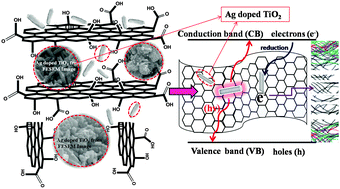Polymorphic transformations and optical properties of graphene-based Ag-doped titania nanostructures†
Abstract
TiO2 is the most studied semiconductor material for photovoltaics and photocatalyst applications, but due to a very large electron hole recombination process it is difficult to use it as a photovoltaics material. In this context graphene-decorated Ag-doped TiO2 nanostructures have been synthesized by a simple, cost effective chemical method. In this paper, we have studied the structural transformations and electronic band structure of Ag-doped TiO2 due to the incorporation of graphene oxide. Pure rutile and anatase–rutile mixed phases of TiO2 nanoparticles were obtained by Ag doping and annealing at 400 °C. A large red shift was observed in most of the graphene-decorated, doped TiO2 hybrid nanostructures, which is because of the electron transfer between the conduction bands of the doped TiO2 and the multilayer graphene. The Ag-doped TiO2 nanoparticles appear in the shape of a bunch of bananas (or rice-like) because of the jumbled collection of particles, which remain unaltered even after graphene decoration. The strong electrical coupling of Ag-doped TiO2 with reduced graphene oxide produces an advanced hybrid material useful for superior photovoltaics, photocatalytic activity and other applications.



 Please wait while we load your content...
Please wait while we load your content...